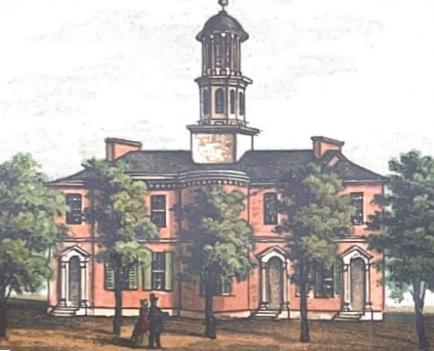
Frederick Douglass’ visit to Harrisburg was met with support from the anti-slavery community, yet largely overshadowed by the racist mob which attacked him during his speech. Reports of the mob made their way to newspapers across the country, illustrating to many, including Douglass, the North’s role in perpetuating slavery and racism in the United States.
In the summer of 1847, two giants of the Abolitionist movement, Frederick Douglass and William Lloyd Garrison, took a tour of Pennsylvania speaking at various abolitionist societies and meeting other prominent figures in the movement to end the institution of slavery, which had plagued the nation long before 1776.
Douglass, the more famous of the two, escaped slavery and later became one of the most notable orators, writers, thinkers, and abolitionists of 19th-century America. Douglass was an especially charismatic orator known for his abilities to speak and command a stage and to capture the hearts and minds of his audience. Garrison, in contrast, was known as a more timid, introverted man who focused on writing rather than speaking. Both men were controversial even for abolitionists, causing splits in the anti-slavery camp by criticizing the emigration movement and emphasizing the improvement of the lives of Black people in the United States.
Douglass and Garrison’s visit to the capital region came at a time of growing optimism in the anti-slavery cause when multiple states were passing legislation in support of abolition. Harrisburg itself became a center for the abolitionist movement despite the persistence of a pro-slavery sentiment in the capital.
On the morning of August 7, 1847, Frederick Douglass and William Garrison arrived in Harrisburg after a difficult train ride in which a belligerent and bigoted man harassed Douglass. Douglass and Garrison walked several blocks to the Dauphin County Courthouse where they were scheduled to speak about their work and the ill of slavery in the country. Garrison spoke for an hour without issue and then gave the floor to Douglass. While the crowd had been very respectful and listened to Garrison’s speech, Douglass encountered bigotry only after a few moments. Rabble-rousers in the audience began throwing rotten eggs at Douglass. It didn’t end there, as the mob set off fireworks outside and lobbed another volley of eggs toward him, one of which hit Garrison in the back of the head. Some were shouting racial epithets at Douglass.
Following this reaction, the abolitionists promptly concluded their speaking engagement. Garrison announced to the people, "Our mission to Harrisburg is ended. If there be not sufficient love of liberty and self-respect in the place, to protect the right of assembly and the freedom of speech, [Douglass] would not degrade himself by attempting to speak under such circumstances, and he would therefore recall the appointment for Sunday night and go where he could be heard."
As their security escorted Douglass and Garrison to leave, a mob harassed them under the complacent watch of Harrisburg police. After the incident, they went to visit some colleagues in the anti-slavery movement at Wesley Union Church, where they received a much better welcome. At the time, Harrisburg had a sizable free Black population of 11%, most of whom created communities around the AME, Zion, and Presbyterian churches.
The remainder of their tour in Pennsylvania was not as difficult or memorable as the time in Harrisburg. Upon arriving in Pittsburgh on August 9, a notable abolitionist of the area, J.B. Vashon, welcomed them alongside a brass band. In his speeches, Douglass argued against the institution of slavery, appealing to the people’s religious sensibilities. Mainly, Douglass argued that owning people as property violated the Golden Rule as well as the democratic principles laid out in the Declaration of Independence. More controversially, Douglass said that the Constitution was a pro-slavery document especially because of the clause stating that runaway slaves should be returned to their enslavers. He also described the North as complicit in keeping slavery alive. Douglass, addressing these pious abolitionists, also railed against the clergymen who defended slavery, calling them hypocrites who dishonored the profession.
After their speeches, Garrison and Douglass met with Dr. Martin R. Delany, who later helped Douglass finance and establish his publication, the North Star. They later met some other abolitionists in Youngstown, Ohio and concluded their tour on August 14. The men would go their separate ways after that.
In the end, Frederick Douglass and William Lloyd Garrison sought not to change minds and gain new supporters in their tour of Pennsylvania (as they were largely speaking to already established abolitionist societies), but to motivate, inspire, and give direction to abolitionists.
The work of these men was instrumental in the end of slavery and played a role in the dominoes leading to the Civil War a few years later in 1861. Without them, landmark civil rights legislation such as the 13th, 14th, and 15th Amendments would probably not have been possible. These changes to the Constitution freed enslaved Americans, made all people equal under the law, and gave all men the right to vote, respectively.
A full list of the resources for this story can be accessed here.
Images


